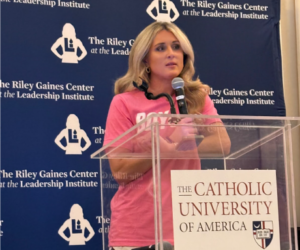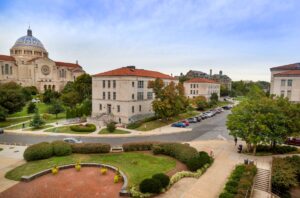Healing the Breach of Trust: Panelists Take a Scholarly Approach to the Church’s Sex Abuse Scandal
By Miriam Trujillo
This Wednesday in Heritage Hall, Catholic University hosted the second of its “Healing the Breach of Trust” conferences, a series spanning the school year attempting to address the Catholic Church’s ongoing sex abuse scandal.
The lectures, masses, and panel discussions went from 8:15 a.m to 4:00 p.m.,and featured speakers such as President John Garvey, Cardinal Daniel DiNardo, and Catholic University’s philosophy professor Michael Root. This particular conference was entitled “The Role of the Laity in Responding to the Crisis: Theological and Historical Foundations.” It proved to be a thoughtful, academic discussion on how the laity should involve themselves in ending the scandal.
The penultimate lecture of the day entitled “‘Won’t Someone Rid Us of These Troublesome Priests?’ The Long History of Lay Engagement with Clerical Misbehavior” exhibited an effort to understand where clerical abuse originated and what authoritative figures of the past have done to address it. In this lecture, historian Dr. Carlos Eire took the audience through some historical instances of abuse and examined the actions of reformers. He mentioned that an unlikely disciplinarian of guilty clergy turned out to be none other than the infamous Spanish Inquisition. The Inquisition took it upon itself to lay bare some cases of historical abuse, calling upon members of the laity to inform it of abuses that had gone on in sacred places. The strictness of the Inquisition, although so regrettable in other instances, actually proved to be a great help in acknowledging just how heinous a crime clerical sexual abuse is and in giving offenders
The final talk, called “Every Christian Prophet, Priest, and King” given by Root, took a practical approach as he considered just how the laity and clergy should work together to help end the scandal while still maintaining their proper roles in the structure of the Church. He reminded his listeners that the Catholic Church differs from Protestant denominations in that there is an appointed hierarchy. Lay outrage over the scandal is appropriate, but it would be unhelpful if that outrage turned into a revolution, discredited the hierarchy as a whole, and undermined the structure of the Church. Rather, lay members must remember that they too have been given a role as priest, prophet, and king in reflection of Jesus’ triple function. The laity’s role should work in harmony with the clergy’s more intense role of government in the Church. This is vital for the Church’s growth. In order to properly realize that collaboration, Root claimed that the lay members need to fully develop their underrated role as kings and help their Church maintain its duty of putting truth into practice:
“The leadership of the clergy calls for a collaboration with the laity. . . these governances [of the clergy] are not handled in isolation from the body of the Faithful,” said Root.
The speakers’ overall vision was a hopeful one. The Catholic Church is a structure that can and should heal itself of such crises. She already has a ruling body whose members will only remain true witnesses of God if they practice the Truth that they were given. She already has a body of faithful who have enough resources to discern truth from hypocrisy. She already has the faith that God is invested in her, and will help her through crisis. The Church has these expectations and guidelines set into her structure. In the present day, Catholics are a long way from fully realizing these expectations, but the way before them is clear— we can only live out the Church’s call by refusing to tolerate the abuse of innocents.







